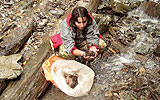
The Tisza Group experts and
stakeholders head towards the Plan
As the Danube River Basin Management Plan heads for adoption, the five countries sharing its largest sub-basin – the Tisza River Basin – enter the last stretch towards an even more advanced and detailed integrated water management plan.

The joint Ukrainian-Romanian environmental campaign cleans the Upper Tisza under the slogan, “Two banks–One clean Tisza”.
Ukraine, Romania, Slovakia, Hungary and Serbia have come a long way since 2004, when they established the ICPDR Tisza Group with a mandate to prepare the integrated Tisza River Basin Management Plan, due in 2010. Today they are a step from raising the stakes in integrated water resources management planning. The latest benchmarks were set in November in Kosice, Slovakia, where the Tisza Group experts, stakeholders and UNDP/GEF project managers met to compare notes and consolidate efforts in the year to come.
“The Plan will be the first one in Europe on a subbasin level to integrate water quality and quantity issues,” says Marieke van Nood of the European Commission Environment Directorate-General, and the co-chair of the Tisza Group. The Plan will go beyond the EU Water Framework Directive (WFD) requirements, and provide valuable lessons for dissemination throughout the Danube River Basin and globally.
The first milestone was reached in 2007, when the Tisza Group endorsed the Analysis of the Tisza River Basin. Water quantity management – water flow regulation – and its influence on water quality management was identified as the key issue in the Tisza Basin. The Plan addresses both water quality and quantity issues, and will provide a novel, combined approach for land and water management, flood and drought.
UND/GEF contribution to transboundary management. As of 2008, a three-year UNDP/GEF Tisza
Medium-size Project (Tisza MSP) integrating multiple
benefits of wetlands and floodplains into improved
transboundary management of the Tisza River Basin
supports the efforts of the riparian states to reach the
‘good status’ required by the WFD and to finalise the
Plan. The Project focuses on developing strategies for
nutrient reduction and flood/drought mitigation, and
on implementing demonstration projects. It contributes
to the improved transboundary management in
two ways:
• By adopting policies and legislation that promote the
use of wetlands and floodplains in line with integrated
water resource management and the WFD and
• By implementing new policies through communitylevel
demonstration of effective floodplain management
for nutrient retention, habitat restoration and
flood management.

Cleaning of the creek from wooden residues and restoration of its weaving and establishment of the cascades by Dilove forest enterprise.
The links between these are crucial for demonstrating the integrated water quality and quantity management approach. Feedback from the field is being incorporated in the Integrated Tisza River Basin Management Plan, and contributes to the development of the Plan from both a ‘top-down’ and a ‘bottom-up’ perspective.
In line with the WFD, public participation is especially important for the development of river basin management plans because they integrate environmental goals, social concerns and economic factors. Following the strategy developed by the ICPDR for public participation throughout the Danube River Basin, the input from the stakeholders is a central component of the UNDP/GEF Tisza MSP.

The Institute of Hydrobiology introduces macrozoobentos from an undisturbed creek.
Demonstrating sustainable management. Three demonstration
projects, which started in spring 2009 at
several locations throughout the Tisza River Basin, are
developing practical and cost-effective ways to address
pressures typical for the Tisza River Basin, to be replicated
and disseminated:
• Reconnecting wetlands for flood protection: improving
the capacity of wetlands to retain, store and drain
excess water, implemented in the Bodrog River Basin
shared by Slovakia, Hungary and Ukraine;
• Integrated land development: how to overcome
fragmentation and unclear land ownership for sustainable
resource management, implemented in Hungary,
Serbia and Romania; and
• Waste and river bank management: dealing with
multiple pressures – hazardous, organic and solid waste
pollution, and floods, implemented in two mountainous
Upper Tisza villages on Romanian/Ukrainian border.
“The projects cover some of the main problems of the Tisza Basin. The experience gained will greatly contribute to the development of the Plan,” says Peter Whalley, the Tisza MSP project manager.
Although different in nature and in scope, the demo projects already have interesting field progress to report. The most visible and already in use are the changes brought by the Upper Tisza demonstration project: a plastic bottles collection system and recycling programme, and creek restoration. Thanks to joint mobilisation of children, stakeholders and local authorities, the team is now expecting the return of trout to clear creek waters, and is ready to share experiences and tips throughout the basin, in a project supported by local authorities.
Disclaimer
The information contained in the ICPDR website is intended to enhance public access to information about the ICPDR and the Danube River. The information is correct to the best of the knowledge of the ICPDR Secretariat. If errors are brought to our attention we will try to correct them.
The ICPDR, expert group members, nor other parties involved in preparation of information contained on this website cannot, however, be held responsible for the correctness and validity of the data and information provided, nor accept responsibility or liability for damages or losses arising directly or indirectly from the use of the information conveyed therein.
Only those documents clearly marked ICPDR documents reflect the position of the ICPDR.
Any links to other websites are provided for your convenience only. The ICPDR does not accept any responsibility for the accuracy, availability, or appropriateness to the user's purposes, of any information or services on any other website.
When using the information and material provided on this website, credit should be given to the ICPDR.
